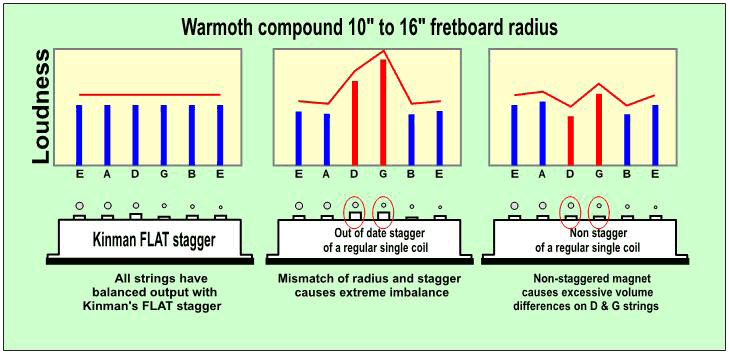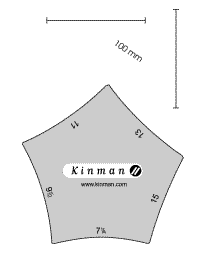'NOTE: This information is copyright and must not be used for commercial purposes by any other party. Chris Kinman (c) 1998.
See Radius Gauge Compound Radius explained
UPDATED 2-Apr-2024 Expanded Radiii Offered
How I match my magnets to different fretboard radii, including Warmoth 10-16" compound radius
It has been said that vintage pickups sound so good because they have certain imperfection (excessive string pull resulting in string crash and buzz, pitch instability (Strat-itis), overbearing G string that sounds like a chain saw, 60Hz hum etc etc), however I strongly disagree. I reckon they sound so good because of some fundamental electrical characteristics and that they sound great in spite of these imperfections.
Basics: The distance between a string and magnet determines the loudness of the string so one might conclude that to get excellent balance of string outputs the magnets should all be the same distance from the strings. But fretboards are usually radiused (arched / cambered) and since the strings follow that radius we find magnets of different lengths arranged in an arc (ostensibly to match the arc of the strings). However, in practice some strings generate more output than others. For example the non-wound G string of modern string sets is mush louder than any other string, the B string also is somewhat louder while the D string is somewhat softer. That's why pickups have magnets of different lengths (staggered) to help compensate for the strings that are louder than others, so that all strings sound balanced.....ie they all have the same loudness. Another significant aspect of this story is that Leo Fender designed his fretboard radius for playing comfort, with a tight radius of 7-1/4", which is easy for fingers to form bar chords.
Problems: The traditional stagger of old Stratocasters was originally designed for a wound G string that was predominately used in the 50's and 60's. In the late 60's the Blues influenced musical styles and guitar players began stretching notes upwards by bending the strings. They soon discovered that a non-wound G string could be stretched (bent) far easier and further than a wound one. But a non-wound G string is a rogue and has dramatically more output and the increase in volume means it dominates all the other strings. It jumps out and can be heard as the loudest string, standing out dramatically in licks, runs and chords. This rogue string also misbehaves in terms of not oscillating at a stable frequency. And because of it's mass and low tension, it tends to succumb to the magnetic influence of the pickup and at elevated levels sounds akin to a chainsaw or buzzsaw. This is especially true with Class-A amps. This is actually a combination of the string crashing into the frets and frequency instability (Strat-itis). So we end up with a mix of Strat-itis and fret crash, I can't imagine anything more horrible and un-musical.This also translates into distortion sounds and, as with clean sounds, it is really quite objectionable and unpleasant (very un-musical). Pickup manufacturers never caught up to the modern style of playing and retained the old out of date stagger, many still to this day.
However a geometric problem exists with extreme stretching on Leo's 7-1/4" radius fretboard in that strings tend to bottom onto the frets resulting in choked (deadened) notes, particularily in the upper register. Players compared notes and noticed that flatter fretboards like Gibson's 11" radius did not have this choking problem. Realizing the advantages of a flatter radius some manufacturers (who were looking for a gimmick to increase market share) conceived the compound radius. Done sensibly, a compound radius is a clever way to combine the comfort of Leo's fretboards in the lower register with the anti-choking properties of Gibson's fretboards in the upper register. However not all compound radius are sensible and some actually create another problem with string output imbalance. The result is the G string is excessively loud and the two E strings are excessively soft when vintage magnet staggers in the pickups are used. Using non-staggered magnets improves balance somewhat but still there is the big difference in output between the G and D strings as well as a significant difference to the other strings.


Solutions: One magnet stagger can't possibly match all the different fretboard radii options available on modern guitars. Magnet staggers are set at time of manufacture and can not be changed, so to solve this dilemma I offer several radius options. First is the (fully compensated) stagger in the 7" to 14" radius range that suits most guitars (such as Fender, Musicman, G&L etc, see Table below).
In July-2008: I introduced specifically designed magnet stagger to suit Warmoths 10-16" compound radius fretboard or any flatter fretboards ranging from 14" to 20".
In March 2024 In response to the latest trends I expanded the range of fretboard radii and magnet staggers to include the following ...
All measurements are M@LF meaning measured at last fret.
All can be ordered to suit non-wound and wound G-3rd strings.
All Kinman magnet staggers are engineered to compensate the D and G strings for balanced output with all other strings. It's a perfect solution and is much better than regular non-staggered magnets.
ORIGINAL FENDER and COPIES (M@LF)
- Uniform 7-1/4 ~ 9-1/2 inch (M@LF) Vintage & Modern Fender and copies (most common)
- Uniform 10 ~ 13 imch (M@LF) including Fender Player Plus and Ultra series that have uniform 12 inch, not common (but, may have Compound 10 ~ 14 inch below)
- Compound 7.25 ~ 12 inch (M@LF) Fender Deluxe Compound radius made after 2010 (not common)
- Compound 10 ~ 14 common (M@LF) & Fender Player Plus made after 2010 and Ultra series that have 12 ~ 16 inch as well as other Fender 12 ~ 16 inch (M@LF (uncommon)
OTHER uniform radii
- Uniform 14 ~ 18 inch (M@LF) (very uncommon)
WARMOTH
- Compound 10 ~ 16 inch (M@LF) Warmoth (common)
- Warmoth also make other radii including Uniform so choose the most appropriate from the first 5 points above.
OTHER Compound radii
- Type it's measurements into a box
NOTE: When a wound G-3rd string is used with a magnet designed for non-wound string the wound string will have significantly lower output. If you contemplate alternating both types of string it's better to choose a stagger for wound G string. When you are using the non-wound string it will be louder than the others but that is preferable to one that has lower output.
Special note about Jimi's Reverse Stagger: I believe Jimi got his sounds in spite of the reverse stagger and that he just learned to live with it. So I do not recommend a reverse stagger to emulate Jimi's sound. All this does is lower the output of the A string and that's definitely not very pleasing. If you want to emulate Jimi's sound you will be thrilled with the Woodstock's performance and once you hear them you won't regret not getting Jimi's reverse stagger, I promise you.
The radius range is marked on the base of the pickups as well as on the label in the box. The table below gives you a rough guide as to the radius of some common guitars.
- RADIUS CHART -
All radius can be supplied in either Right or Left hand.
| RANGE range in inches | BRANDS and MODELS |
|
Improved stagger 7" - 9-1/2" |
All Strats* including those with Floyd Rose bridges, Japanese Squiers*, G&L, Fernandez, Tokai, Korean Squiers, Musicman, Yamaha Pacificia (standard) and most other guitars with traditional bridges. Not PRS bolt on neck models. |
|
Compound Radii ending in 12" ~ 16" |
Warmoth 10"-16" compound, Yamaha Pacificia (only their compound neck), Parker Fly: check Parker website >Resourses >Specifications >Model >Fretboard shape (most seem to be either 10"-13" or 10"-15") |
Check your radius, if you're not sure what it is, better shops and good repairmen quite often have radius gauges that can measure this. If you prefer to measure it yourself, download the instructions and templates below.
INSTRUCTIONS FOR MEASURING THE RADIUS OF YOUR FRETBOARD.
Below you will find a number of files containing a fret board radius gauge which looks a bit like this:
 |
Using scissors or an artists scalpel, carefully cut the radius out as neat and accurate as possible. Then, after loosening your strings, find which of the templates fits the radius of your fret board the closest. If the curve only touches the middle of the fret board then it is too big, if it only touches the sides then it is too small. |
| "Ding formatraws" | These tend to be smaller but you really need some CAD or drawing software to print them. In general, if you don't recognise the format then you probably can't use it. | |
| radius.pdf | 12 kb | Adobe Acrobat - Portable Document Format |
| radius.cdr | 19 kb | Corel Draw |
| radius.wpg | 13 kb | Word Perfect Graphic |
| radius.wmf | 41 kb | Windows Meta File |
| radius-pc.ai | 64 kb | PC version Adobe Illustrator |
| radius-mac.ai | 64 kb | Mac version Adobe Illustrator |
| radius.dxf | 70 kb | AutoCAD |
| "Bitmaps" | These are larger but as long as you make sure your printer resolution is set right you shouldn't have too much trouble with them | |
| radius300.gif | 41 kb | 300 DPI compuserve-Graphics Interchange Format for printing on a laser printer |
| radius300.cpt | 169 kb | 300 DPI Corel Photo Paint for printing to a ink laser printer. |
| radius300.eps | 2.0 mb (huge) | 300 DPI Encapsulate PostScript for printing to a Mac laser. |
| radius360.gif | 52 kb | 360 DPI compuserve-Graphics Interchange Format for printing on a ink jet type printer |
| radius360.cpt | 219 kb | 360 DPI Corel Photo Paint for printing to a ink jet type printer. |
| radius360.eps | 2.8 mb (huge) | 360 DPI Encapsulate PostScript for printing to a Mac ink jet. |
